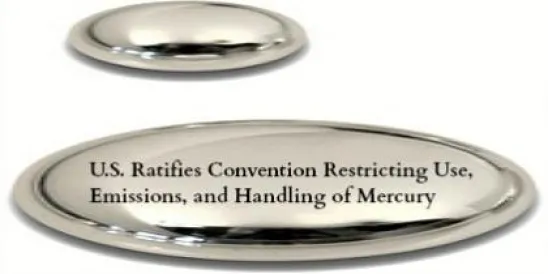Last week, the United States became the first country to deposit its instrument of acceptance (equivalent to a ratification) to the Minamata Convention on Mercury. The Convention restricts the use, emissions, and handling of mercury across a variety of industries, including electronics, energy, mining, and waste.
The Obama Administration has evidently taken the position that the Convention does not require new implementing legislation in the United States at this time. The Administration also took the highly unusual step of ratifying the Convention without first seeking advice and consent of the Senate, possibly reflecting some frustration with the decades-long challenges Presidents of both parties have encountered in obtaining Senate approval of treaties generally and international environmental agreements in particular.
Key provisions of the Convention include:
-
A list of mercury-added products to be banned by Party countries by 2020. The current list includes many batteries, fluorescent lamps (including those used in electronic displays), measuring devices, pesticides, and cosmetics. A mechanism was also established whereby other mercury-added products could be banned.
-
A mandate for the use, within five years of entry into force, of “best available” techniques and practices to control mercury emissions from several major source categories, including coal-fired power plants.
-
Phase-out of primary mercury mining within 15 years of entry into force.
-
A mechanism whereby guidelines for the handling, transport, and disposal of mercury-containing waste may be established.
A total of 93 countries have signed the Convention since it was opened for signature in Kumamoto, Japan last month. The Convention will enter into force upon ratification or accession by 50 states. The text of the Convention had been in development under the auspices of the United Nations Environment Program (“UNEP”) since February 2009.
Mercury-Added Products
The Convention establishes a new global framework for restricting the use of mercury in products. Specifically, the agreement contains a list of mercury-added products for which state Parties must prohibit the manufacture, import or export by 2020. Parties may register for exemptions from the phase-out date of up to five years, with an extension of up to five more years available upon approval of the Conference of the Parties (“COP”). The convention requires the COP to review the list of banned mercury-added products no later than five years after entry into force. When considering amendments or additions to the banned product list, the COP must take into account any proposals submitted by the Parties, relevant information submitted by the Parties, and the availability of mercury-free alternatives.
Mercury-added products to be banned by 2020 include:
-
Batteries (except for zinc silver oxide button batteries with mercury content less than 2% and zinc air button batteries with mercury content less than 2%);
-
Switches and relays (except very high accuracy capacitance and loss measurement bridges and high frequency radio frequency switches and relays in monitoring and control instruments with maximum mercury content of 20 mg per bridge, switch or relay);
-
Compact fluorescent lamps (“CFLs”) for general lighting purposes not greater than 30 watts with mercury content exceeding 5 mg per lamp burner;
-
The following linear fluorescent lamps (“LFLs”) for general lighting purposes: triband phosphor of less than 60 watts with mercury content exceeding 5 mg per lamp; halophosphate phosphor of not greater than 40 watts with mercury content exceeding 10 mg per lamp;
-
High-pressure mercury vapor lamps (“HPMVs”) for general lighting purposes;
-
The following cold cathode fluorescent lamps and external electrode fluorescent lamps (“CCFLs” and “EEFLs”) for electronic displays: short length lamps with mercury content exceeding 3.5 mg per lamp; medium length lamps with mercury exceeding 5 mg per lamp; and long length lamps with mercury content exceeding 13 mg per lamp;
-
Cosmetics with mercury content above 1 ppm (with some exceptions for eye cosmetics using mercury as a preservative where no effective and safe substitute preservatives are available);
-
Pesticides, biocides, and topical antiseptics; and
-
The following non-electronic measuring devices (with some exceptions for devices installed in large-scale equipment or those used for high-precision measurement where no suitable mercury-free alternative is available): barometers; hygrometers; manometers; thermometers; and sphygmomanometers.
The Convention’s provisions restricting mercury in products represent an important evolution in the development of global environmental accords that could serve as a precedent for further product restrictions at the global level.
Other Restrictions on Mercury
The Convention contains other provisions restricting uses of mercury, as well as restrictions on mercury mining, transport, and emissions. For example, the Convention requires state Parties to take action that will:
-
Within five years of entry into force, mandate the use of “best available” techniques and practices to control mercury emissions from the following source categories: coal-fired power plants; coal-fired industrial boilers; smelting and roasting processes used in the production of non-ferrous metals; waste incineration facilities; and cement clinker production facilities.
-
Forbid new primary mercury mining immediately and existing primary mercury mining within 15 years of entry into force;
-
Only allow the export of mercury to Parties and non-Parties providing written consent (and certification, for non-Parties) and ensuring that the mercury will not be used in a way forbidden by the Convention; and
-
Prohibit or restrict the use of mercury or mercury compounds in the production of certain chemicals, including: chlor-alkali; acetaldehyde; vinyl chloride monomer; sodium or potassium methylate or ethylate; and polyurethane.
Waste Provisions
The Convention also contains a mechanism whereby guidelines for the handling, transport, and disposal of mercury-containing waste may be established. The guidelines would apply to waste substances or objects consisting of, containing or contaminated with mercury or mercury compounds at a threshold level to be established by the COP in collaboration with the relevant bodies of the Basel Convention, and would be drafted taking into account Parties’ existing waste management regulations and programs. The extent to which used electronics destined for reuse, refurbishment or recycling constitute waste is an active topic of discussion under the Basel Convention and the outcome will be important in light of potential new obligations in relation to the management of mercury-containing wastes.





 />i
/>i

